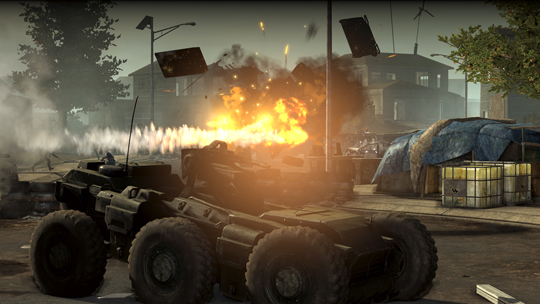
First-person shooters, especially those based in real-world military settings, haven’t exactly exhibited a track record of thematic innovation, but with Homefront, THQ aims to change that. The game’s tagline, "home is where the war is," perfectly describes exactly what this high-concept first-person shooter aims to do best when it arrives early next year, which is make the player truly feel the strain and desperation of being forced to fight for one’s homeland under the oppression of foreign military occupation.
I was in attendance at a recent press event in Montreal, where I spent a short play session examining the earliest portion of the single-player campaign. What I experienced was still rough around the edges, which is to be expected, but it did exhibit evidence of what may be an emotionally charged narrative delivered through its well-fleshed world and extensive fiction.
The demo began as the game’s protagonist, still under my control, was kidnapped by officers in the Korean People’s Army (KPA), put on a local school bus that had been converted into a prison bus, and driven through town to an unknown destination, presumably to serve the new Korean regime. This was the most powerful portion of the demo in narrative terms, as it forced me, immobilized, to look out the bus windows at the town around me and observe the horrors of the nation’s misfortune. I watched as citizens were herded at gunpoint into lines to who-knows-where, including a married couple harshly torn apart, as well as a number of almost nonchalant curbside executions, the worst of which being a mother and father positioned against a concrete wall before being shot in front of their roughly 5-year-old son. This part of the game is one of what THQ calls a "why we fight" segment, and absolutely succeeded at building the anger and sadness that made finally getting my hands on a gun an exhilarating and vengeful moment. Unlike military shooter X, Y, and Z, this time I was actually ready to kill those bastards.
I got my chance when a semi cab barreled down a cross street and into the bus, flipping it and freeing me from my captors. My rescuers had instantly made me a part of the resistance, and rather than hiding out in one of the remaining American communities dotting the map, I was willing and able to take the fight to the new regime. Soon after grabbing a pistol and taking out a few KPA officers, the game treated me to a surprising variety of assault weapons with which to… express myself. I’m not certain if this selection was assembled specifically for preview purposes, but if not, it suggests that the game’s entire arsenal will be both substantial and interesting.

The play mechanics still exhibited characteristics of an early build, however. The two AI characters accompanying me were clumsy and slow, and managed to get in my way fairly often. The paths and arenas through which I navigated and fought were very limited, so firefights consisted primarily of crouching behind cover and peeking out to target enemies one at a time. The game features no automatic cover mechanics or stop-and-pop system, but lets players instead crouch, lie prone, and jump at will. In the segment I played, opportunities for flanking and similar tactics were limited to scripted situations that called for such maneuvers, although objectives were relatively diverse for such a short portion of gameplay. I also noticed that aside from a very cool manipulation of a remote-controlled tank called Goliath, the gunfights themselves followed a very familiar formula, with enemies arriving from one direction or another and then popping up from behind cover at a few distinct points around the environment.
Before finishing off the demo with the aforementioned Goliath tank at my command, I played through a few scenarios that showed off the game’s narrative integration, which it seems to do well. I found myself learning about the resistance and meeting new characters as I moved from combat situation to combat situation, at one point having to confront the enemy from a suburban home while a mother and her infant child wailed at my comrades and me from the background. Kaos Studios seems dedicated to constantly reminding the player that he or she is truly fighting a war at home.
Since our first look at the game, Homefront may have lost some of the dynamics that had been initially suggested about its gameplay, but Kaos has remained mindful of the player experience, and is packing plenty into the more linear play I observed in Montreal. Especially in terms of narrative, which happens to be penned by Apocalypse Now and Red Dawn author John Milius, Homefront looks to change the way we look at shooters. Players will feel the weight of this war on their shoulders, and will actually be motivated to do something about it.

















